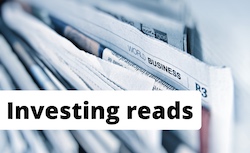New contributor Longshore Drift is back to explain how having a Flexible ISA in his armoury enabled his family to secure their dream home.
After years of vaguely searching, my wife and I suddenly found the house we wanted.
A big garden to swap for our terrace with its five metre square yard in London. An unlikely place – tired, but surrounded by beautiful tall trees. “A single story home of unique design,” according to the agent.
In other words: a 1950s bungalow with a demented layout.
Two hours from London, this bungalow had plenty of space for us, our stuff, the kids, and the dog. Decent schools. A garage that might become a gym and a workshop. Walking distance from a big river.
All of a sudden the abstract notion of moving became real and it required an action plan.
The sellers of the house, like so many since the pandemic, were only interested in engaging with buyers who were, in estate agent jargon, ‘proceedable’.
A second visit confirmed our interest. But were we just wasting everybody’s time? Turning the aimless Rightmove scroll into a real-life experience that was still somehow no closer to happening?
Find funds fast
Our own house was not on the market and not ready to be sold. But we needed to move quickly.
Suddenly all the little jobs around the place that I’d put off for years had to be done. However it was our finances that were in most immediate need of work.
To get this house – the first one we had seriously pursued in more than five years of on-off searching – we’d have to demonstrate that we had the means to buy it. We needed to show that the purchase was not contingent on the sale of our house. That we were serious people. That we had the money.
We were faced with two unpalatable options:
- Get a colossal white-knuckle mortgage, and try to suppress all thoughts of Liz Truss-style fiscal events.
- Get just a very large mortgage while also taking the beloved and hard-won ISAs that we had carefully accumulated for years out back and quietly liquidating them.
The horror!
ISA reluctant withdrawer
I was slow to take pensions seriously. As a consequence, ISAs are a big part of how I plan to keep the lights on when I’m no longer seen as economically viable in the Logan’s Run world of work.
And that could be sooner than I hope. The fear is real.
Yes, dear reader, I am over-45.
Hence I was haunted by the prospect of losing my ISAs – or more particularly the large tax-sheltering capacity that I’d built up over years of diligently using my annual ISA allowance. Decades of future precious compounding lost in an instant. My DIY pension plans unravelled.
After digging around, however, I learned of an exotic variant of the ISA. Something called a Flexible ISA. Created by government mandate in 2016, a Flexible ISA allows ISA funds to be removed and repaid, retaining their tax-free status as long as the money is returned within the same financial year.
This is the closest thing to Johnsonian magical economics I’ve seen in the real world. We could have our cake and eat it – just so long as we promptly coughed it all back up by year’s end.
It could be done! You can’t invest your pension funds in your own house, but you can give yourself a bridging loan from your Flexible ISA.
Now find your flex
‘Mandated by government’ does not mean ‘offered by every ISA supplier’. Banks are not required to offer this ISA flexibility. Most don’t.
My existing ISAs were inflexible: money exiting to the real world would be banished from the tax shelter for all eternity.
So I went on the hunt. After getting a flat “no” from Interactive Investor, Hargreaves Lansdown, Smile, and Starling, I found one with Yorkshire Building Society and promptly opened an account.
This facility could enable us to secure our new home despite the UK’s notoriously protracted house buying process. If we timed our transaction for just after the new financial year starting 6 April, we would have up to 12 months to sell our house and shepherd the cash released back into our flexible ISAs.
We made our offer in January. A transaction early in the new financial year was a realistic prospect. By combining this DIY financial engineering with an offset mortgage (another rare beast) we could do it.
True, if the sale of our house hit problems and things got strung out then it could get a bit hairy. Cash Cinderella must be back home in the ISA by midnight before the tax year ends on 5 April!
Rachel Reeves is not the Wicked Witch, but she’s no Fairy Godmother, either.
Fortune favours
It’s difficult to overstate the importance of our discovering this option, psychologically.
Instead of having to swap one dream for another – a decent retirement for a family home – we could achieve both. The plan gave us the courage to make an offer.
We proved our funds in our existing ISAs, showing the current holdings. After a bit of haggling we agreed a price, secured the house, and got it off the market.
It was the flexible ISAs at our backs that made the stretch a real, practical prospect.
Our Bridge-o-Matic manoeuvre in summary:
| Bridge lending plan | New house cost (inc. Stamp Duty) | Mortgage debt (Offset) | Flexible ISA funds | Old house yield (after fees) |
| Purchase | -£1,200,000 | £800,000 | £400,000 | |
| Sale | -£800,000 | £800,000 | ||
| End state | £1,200,000 | -£400,000 | £400,000 |
So that was the roadmap. Long story short though: we got lucky.
We were able to sell our house very quickly, and so we did not actually need to release the ISA cash.
Still, without this flexible flex as an option we might never have had the confidence to act. We would have missed the house and we’d probably still be aimlessly thumbing our way through Rightmove.
The plan: using a flexible ISA as a bridging loan
Here’s a recap:
- Take statements or screenshots of your ISAs, demonstrate their chunky dimensions to your sceptical seller, be seen as serious people, and have your offer accepted.
- You may now PROCEED!
- Liquidate your ISA investments. A great opportunity to test those – ahem – unfailing instincts for perfect market timing. (Only kidding – indeed being out of the market for a spell is a downside.)
- Use your flexible ISA to spit out the necessary cash – or transfer your existing ISAs to a flexible one that will. The sooner you do it after 6 April, the more time you have to use the money and refund it.
- Buy the house with a mortgage that is now slightly less terrifying.
- Sell your old house and send a chunk of cash back into your flexible ISA, before the tax year taps out.
- Reinvest the ISA money in the
happy bag of meme stocks and crypto ETPslow-cost global trackers that filled your ISA in the first place. - Set any leftover cash against your offset mortgage.
…and start breathing normally again.
Net, flex and chill
Some providers offer flexible ISAs as standard. Many others do not offer them at all.
Given my investment platform declined to offer one, the most practical way for me to use this flexible approach was to sell my investments in my inflexible ISA, transfer the cash to my new flexible ISA provider, and then withdraw the cash.
Again, if you are planning to do this and want the best chance of getting your ISA money back to safety in time, then withdrawing not long after 6 April is your best option. (Another reason for people to pile back into the housing market in the new year?)
While still not widely available today, perhaps there will be more competition for flexible ISAs in the future.
I know that Starling, for one, has begun quietly offering them to some existing customers, though there is nothing on the website right now.
Gimme shelter
You may find your existing ISA already has these magical bridging, property-acquiring properties. If not then it’s worth considering opening one that does with at least some of your ISA allowance – just in case you need the flexibility someday.
You could turn out to be the most generous lender you can find.
Our own flexible accounts are still there, ready to go if we need a chunk of cash.
But please don’t tell any estate agents. We’ve only just finished unpacking from this last move.
Further reading:
- How The Investor demonstrated the value of his investments to secure a big mortgage and hence retain his precious ISAs.








